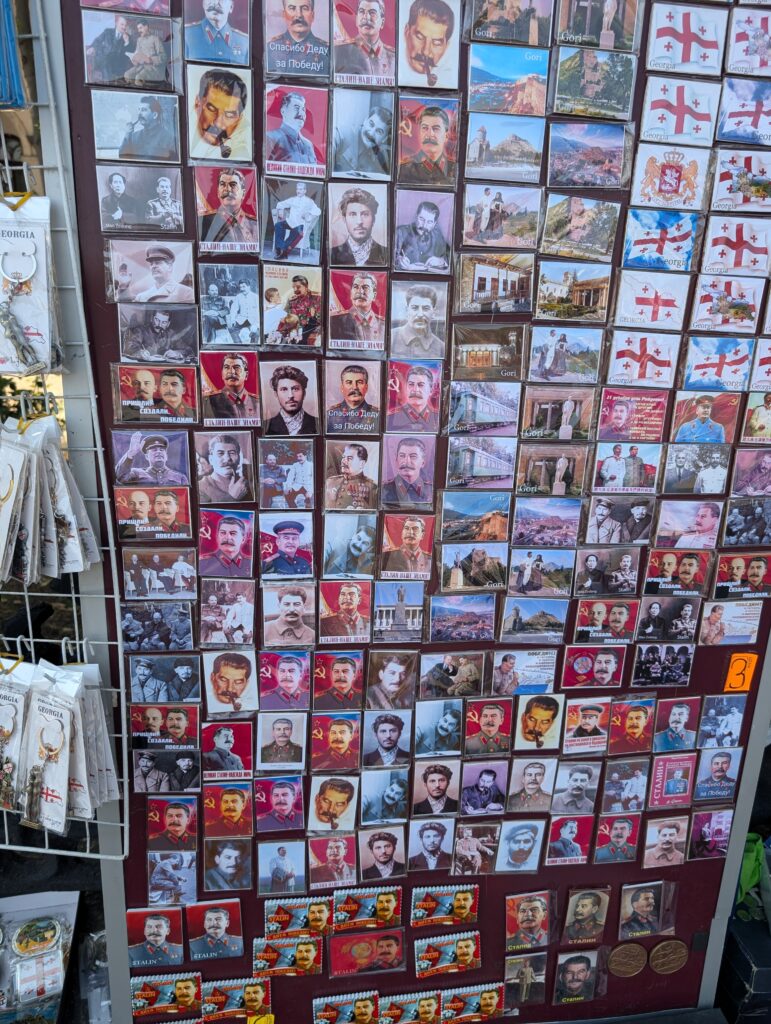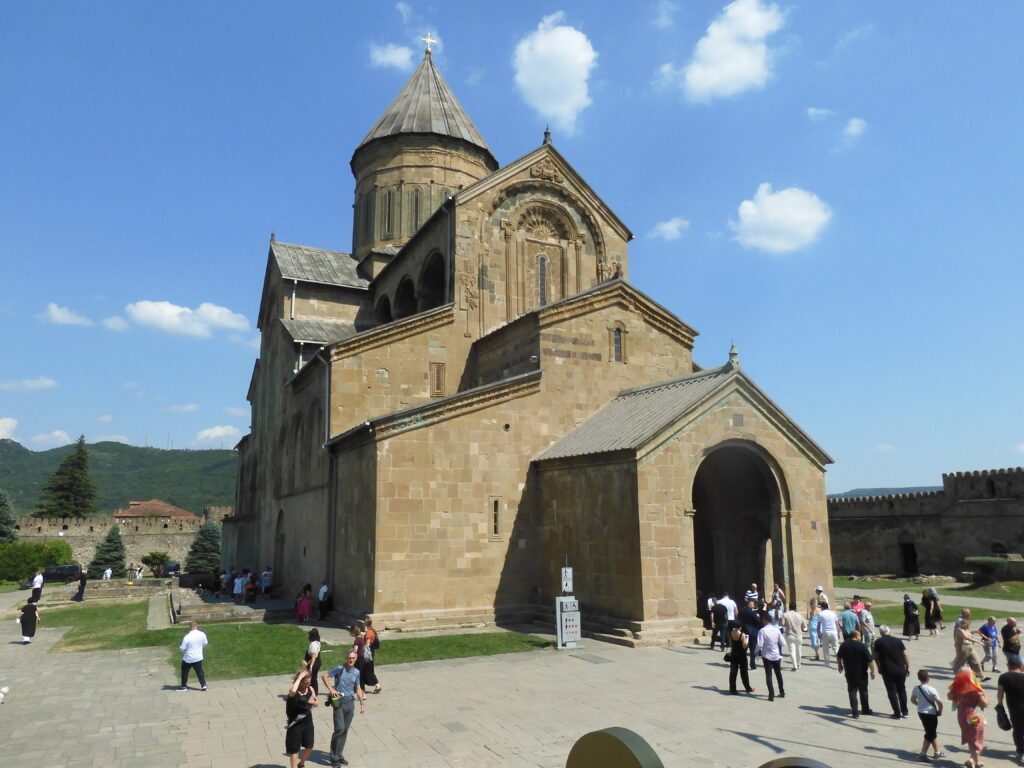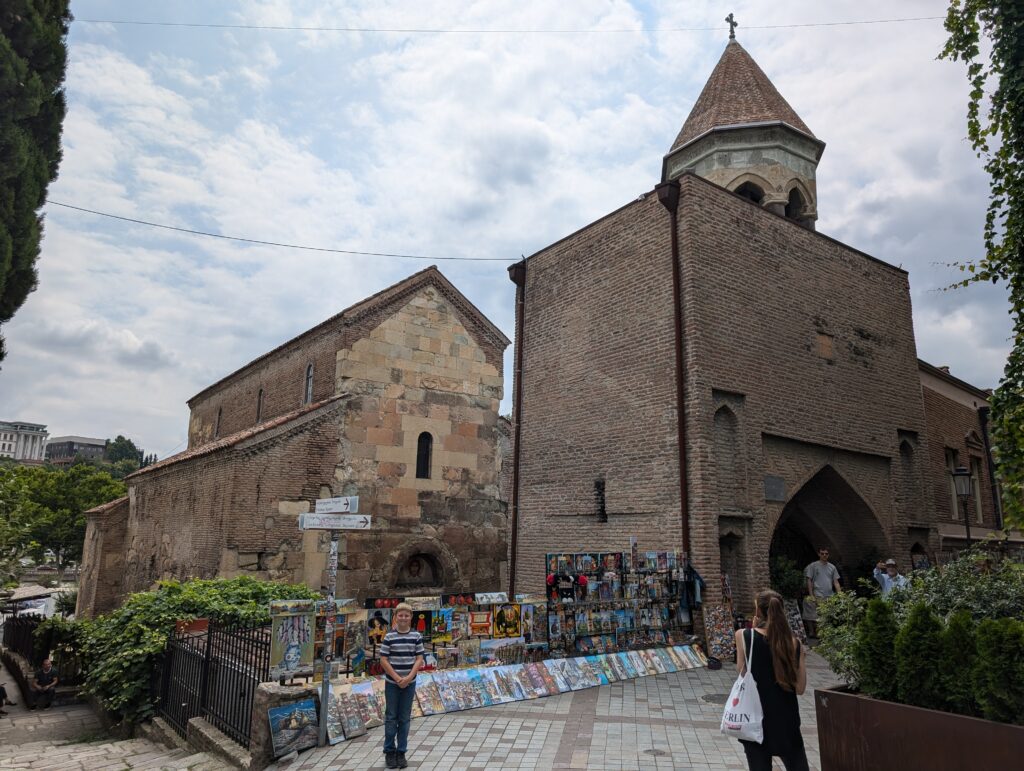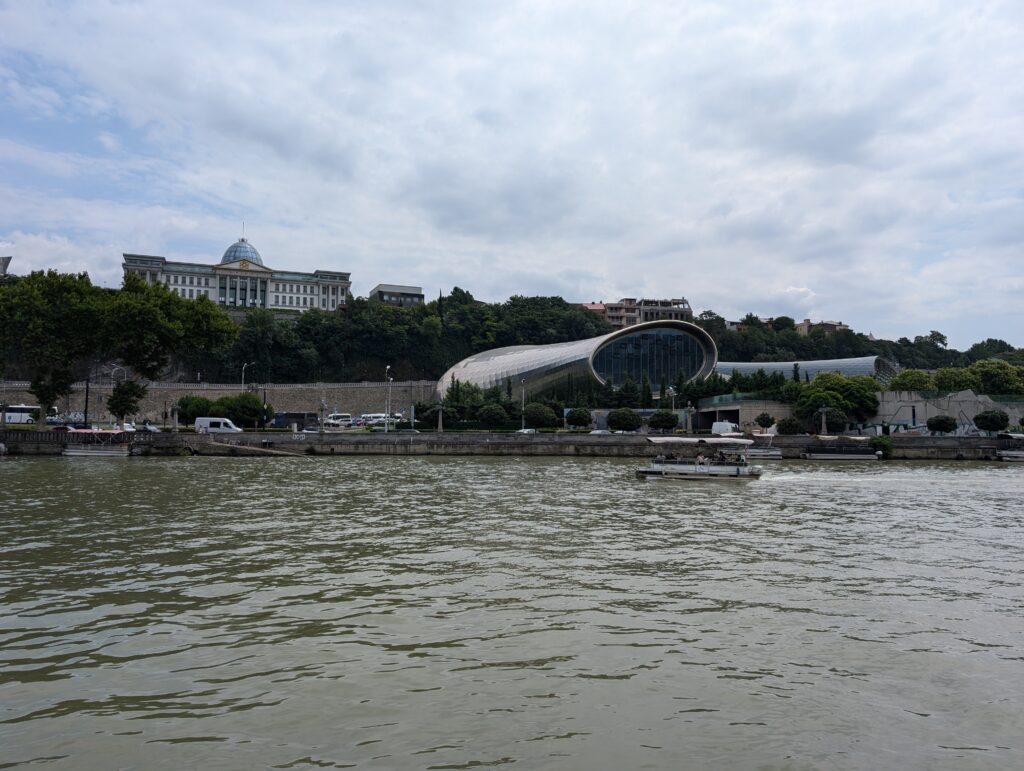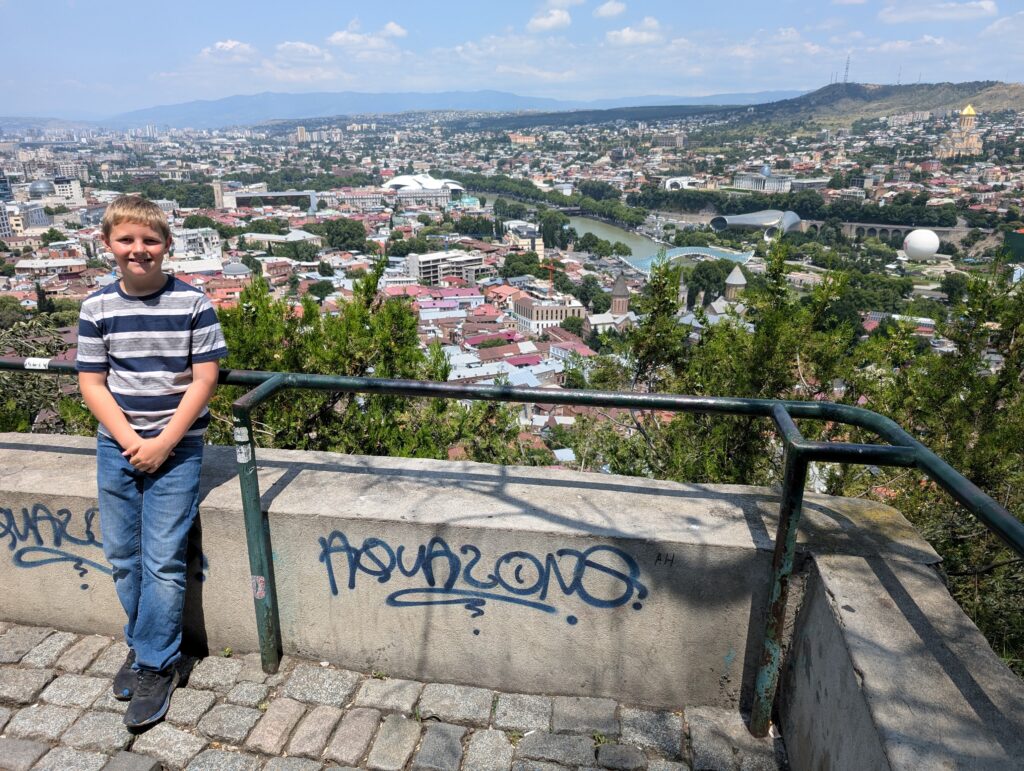Georgia
Not That Georgia
Georgia was the first former Soviet Republic we visited. We passed through several Eastern Block countries, but Georgia had been part of the Soviet Union for most of the 20th century. While I was there, more than one Georgian assured me that Georgia was the “most democratic” of the former Soviet Republics. It was interesting to note now much Soviet mentality remains. The reason to visit Georgia, though, is not so much to contemplate the complex relationship of these peripheral Soviet areas with Russia, but to experience its stunning landscapes.
There are several drawbacks to planning a 100 day trip to two dozen countries. One obvious problem is that there just won’t be enough time to thoroughly experience each place. Time to research visits is another problem. When I go to spend a week or two in a single place, I do thorough research before I leave. Where will I go? What will I do? What should I eat? Can you drink the water? How long do people spend doing this or that? I always discover more things to see and do once I arrive, but I have a solid idea of what the trip will look like before I leave. This was not possible for my circumnavigation trip. We are going to too many places to research them all with that kind of vigor, and I was not even sure what the back half of the trip would look like. I wanted to retain the flexibility to spend more time in a place. I knew whole countries would likely fall off the itinerary. This reduced my motivation to thoroughly research them all before leaving.
I had not done much research on Georgia before we left. I knew it had some nice scenery from photos, but most of what I had read emphasized Georgia’s claim to be the birthplace of wine. That is all interesting, but I am not really a wine connoisseur. I had only a passing interest in this element of Georgia’s identity. Batumi looked like a nice resort on the Black Sea, and I figured we would end up in Tbilisi, the cultural and political Georgian capital. Travelers I met during this trip provided the best information. Travel bloggers all go to the same six or eight spots on the tourist checklist. Of course, fellow travelers often have interests and perspectives that differ from mine. If you filter their information by learning a bit about their perspective and taking those differences into account, you can get a lot more refined information about where time and resources on a visit might be best spent.
I met an older Georgian couple walking the city in Prague. I told them I was going to Georgia in a few weeks and asked for tips. They asked what I had planned, and I mentioned Batumi and Tbilisi. “I have no tolerance for heat,” said Mrs. Georgian, “it is too hot there in July. You should go to Svaneti.” Since I, too, enjoy cool weather, I decided to search out some information on Svaneti. It turns out all the amazing mountain pictures you see from Georgia are from Svaneti. I didn’t even know what Svaneti was when I left North America. It ended up being the centerpiece of our time in Georgia.
On the afternoon of my 52nd birthday, July 5th, we arrived at our motel in Batumi with pasty dried sweat from a 20 hour Istanbul-Hopa bus leg followed by two connecting mini-buses and a hot, crowded border check point. The 1,300 km trip had been taxing, to say the least. After our experience with the Romanian train, I opted for the bus. FlixBuses are generally modern and comfortable with lots of room. In Turkey, FlixBus just bought a company called Kamil Koc (pronounced “Camel Coach”). I figured it would be about like a FlixBus. That turned out to have been an overestimate. Caleb and I cleaned up, then spent the evening exploring Batumi. Batumi has a fun beachfront area with a Ferris Wheel, vendors, para-sailing, and boat rides. The beach itself is more like pea gravel than sand, and the water isn’t the cleanest. There are lots of casinos. There are things to do there, but we decided it wasn’t really our thing. I did some research on how to get up to the mountains, and that’s where we headed after spending a night in Batumi.
The next morning, we rode two marshrutkas (minibuses) to Mestia. We caught the first to Zugdidi – which Caleb understandably thought sounded like an African city – and then waited for the second which would go to Mestia. Marshrutkas supposedly run on the hour from these places, but that was far from the reality. They don’t really follow a schedule. Chain smoking drivers park vans in various states of repair at places likely to attract passengers. They have a sign in the window to let you know where they’re going. They absolutely will not leave until every seat is full. “Wait five minutes, I bring van,” one driver told us when he saw a group of tourists waiting to go from Zugdidi to Mestia.” Since it was possible to squeeze another three or four people in the vehicle, the driver waited for five more people before making his run. This took another two and a half hours. We did get to Mestia, though, and it was beautiful.
We made Mestia our base camp for exploring Georgia’s Upper Svaneti region over the next several days on the advice of the Georgian friends we met in Prague. We eventually even extended our stay there. We began on a Sunday, but could find no Churches of Christ anywhere in the country, and so missed out on another Sunday of the on-the-road worship we so enjoy. We visited the Svan ethnographic museum first to learn more about the Svan people responsible for the striking medieval towers prevalent in the area. It wasn’t a large museum, and there wasn’t much historical context. It didn’t take us long to see all of their artifacts.
We quickly moved on to the Mikhail Khergiani House Musuem. You cannot climb most of the Svan towers. The wood has rotted out over time and it is either impossible or dangerous. This museum has a tower that you can climb, however. That’s why we went. In the process, we learned about Mikhail Khergiani. He was a Georgian world class mountain climber, and the museum was in his childhood home. I believe he still holds several speed records for climbing specific mountains. He won seven world championships in this category during the 1960s. He fell to his death while climbing in the Dolomites in 1969. His climbing career was interesting, and there were a couple of videos playing in either Georgian or Russian showing him just screaming up and down extremely difficult rock faces.
We saved the tower climb for the end. The first couple of levels of the tower had wooden stairs, but the upper levels were accessed by wooden ladders that did not feel like they were made for people my size. As I got to the top of one, I noticed that the tops of the vertical segments had broken off at some point and other pieces had been nailed onto the sides. I squeezed through the tiny holes in the upper levels of floor and peeked out the hole cut in the roof. It was magnificent, and worth every bit of the climb, and the small fee.
I did learn something about Georgian negotiating skills here. On the internet, I had read that the fee for this museum was only 3 Georgian lari (about a dollar), but this was not posted anywhere on-site. I asked the fellow who seemed like a sort of self-appointed museum tender how much it cost. “Ten lari, but boy free.” The ten lari fee also got us a long explanation in Georgian about all of Khergiani’s exploits, with an occasional English phrase thrown in here and there. A Jordanian fellow staying at our guest house in Mestia had joined us for the walk to the museum. Apparently, my 10 lari not only covered Caleb, but Sanad, too! He wasn’t asked to pay anything. I hadn’t considered the difference between three lari and ten worth arguing about. My parsimonious Jordanian friend, on the other hand, was a much sharper negotiator and apparently was able to see the museum on my 10 lari.
We headed back to the room and rested for a bit before heading out on our final activity for the day. About half a mile up the hill from our guest house sat a pair of ski lifts. For 25 lari, you can catch a ride up to a restaurant and eventually to the top of the nearest mountain ridge, which promised to offer even more spectacular views of the Caucasus mountains that form the Georgian border with Russia. A sign said that the lift ceased operation at 5:00. It was already after 3:30, so Caleb and I were concerned about having time once we got to the top. We were told the lift only took ten minutes or so to reach the top. I read that sometimes they didn’t run the upper lift, leaving you to ascend the rest of the mountain, so I was sure to ask if they were both operational. I was assured they were both running, so up we went.
As we approached the top of the first lift, the second one looked stationary. We hiked a couple hundred meters over to the second boarding point, and sure enough, it was stopped. Another couple was there waiting. I asked them how long it had been stopped. “Only about five minutes,” they cheerfully replied. After waiting half an hour and seeing the clock near 4:30, they decided to head back down. A Georgian in another small tourist group asked the technicians how progress was coming, and was told it was about ready to start back up, and that they would keep it running a bit late so we’d have time to spend at the top. We heard some creaks, groans, and beeps a few times, and finally at about 4:30 the second lift was back underway. We hopped on to make our ascent. Three times on the way up, the lift stopped for several minutes. Once we finally arrived at the top, the lone employee there hollered at us, yelling something that obviously meant it was closing time and we were not being allowed out of the car and should just go right back down.
I used my translator to ask at the bottom of the second lift if we could get a voucher for riding the lift another day, and just got yelled at by a technician who couldn’t be bothered to use the translator back. I don’t know what he yelled, but it was obvious that it was closed, I wasn’t getting another ticket, and it wasn’t his fault that it was closed or broken. So, tough luck! Georgia had been part of the Soviet Union for a long time. Nothing feels more Soviet than old, broken down equipment and having no recourse for paying full price for something that doesn’t work.
(Continued)



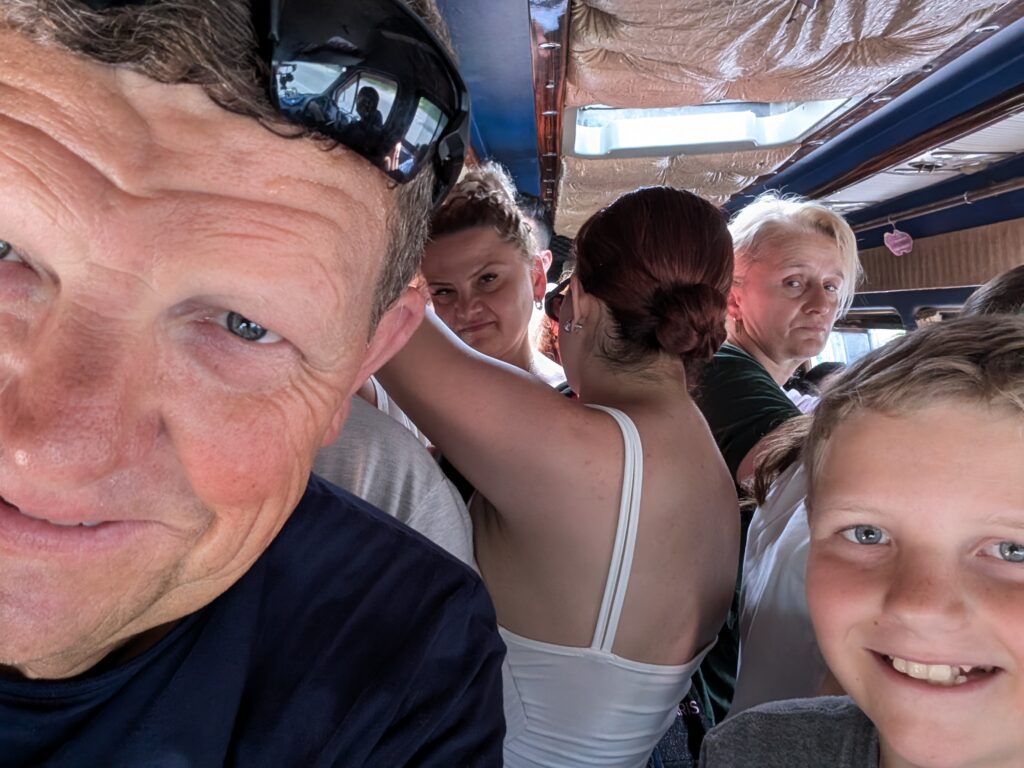




It was then dinner time. Our general eating plan is to eat breakfast in the room and then kind of snack through the day, and eat a purchased meal for supper. I try to eat as much local cuisine as I can when we travel. Georgians love their cheese and butter. We had a lot of good food in Georgia. We have had khachapuri, which is kind of like a cheese pizza, but the bread is not particularly crusty and it is entirely filled with cheese. These can have other fillings such as meat or mushrooms, but they always have lots of cheese. I had tashmijabi, which was kind of like mashed potatoes infused with enough cheese to make the whole thing very stringy. Kudbari was also very good, and kind of similar to khachapuri but different in that it has meat in it, usually lamb. Sometimes it is filled with mushrooms.
Ushguli is a complex of four villages which remained off-road and isolated until only about five years ago. Even now, most visitors arrive after a four day hike. You can either carry your own tent, or stay each night in guest houses along the way. Andrew would have loved to hike this trail through the Caucasus high country, but it would have been a four day complaint trek with Caleb. Now that you can reach the villages by road, I decided to take a marshrutka up, spend the night at one of the guest houses, then come back to Mestia the following day. Many people take a marshrutka day trip to Ushguli, but that only leaves you a couple of hours to enjoy the scenery, hike around, and explore the villages.
Although the distance is only 46km, it takes an hour and a half for the marshrutka to get you there. It is a picturesque drive. We saw a medieval chapel high on a mountain, and some svan towers here and there. The biggest collection of svan towers was in the group of four villages, which run only about 2 kilometers from the first to the fourth. Ushguli is in the peculiar state of being ripped from medieval times straight into the 21st century. The high mountain setting and the medieval stone buildings and svan towers are like nothing I have ever seen from a distance. As you get closer, it becomes apparent that every building that is not falling down has been converted to a guest house. Cows still walk the unpaved streets. At the same time, neon signs advertise rooms with free WiFi. The arrival of the road in the last few years has rapidly accelerated Ushguli’s jump toward modernity. It would be interesting to see what the place looks like in ten more years. I suspect there will be high rises and commercial resorts.
Our guest house was extremely rustic. It was clean, but the walls were made of unpainted particle board. The deck and upper floor were sturdily put together with raw 2x12s. Our facility was in the furthest, least developed village. We did not have climate controls or WiFi, which would have seemed out of place in Ushguli anyhow. Our host spoke no English. She was kind and provided us a delicious meal with huge portions for both supper and breakfast. It seemed from the advertisement as if meals were included in the price of the room. This turned out to be too good to be true. The room was only 55 lari (about $20), but the meals turned out to be another 80 lari! Those turned out to be some of the most expensive meals we ate the entire time we were in Georgia. Caveat emptor! In Georgia, you had better know what is included before you consume it, and negotiate the prices beforehand. Fortunately, this was not financially ruinous by American standards.
Caleb and I walked among the Svan towers in all four villages. We climbed to Queen Tamar’s winter residence. Sadly all that remains of this is a single tower, as the Soviets dismantled the rest of the buildings to use the rocks to fence farm plots. We walked to medieval churches and monasteries. We sat on a hill chatting with the trekkers as we gazed at Shkhara, the highest mountain in Georgia high upon the Georgia-Russia frontier. We sat in awe of the glaciers others had recently hiked. It was a truly amazing experience, all the more for me as I had not even known of Svaneti when we left North America.
I bought the tickets for the next few weeks of the trip the day before we went to Ushguli. For reasons I will explain in the Azerbaijan article, you cannot cross the Georgia-Azerbaijan land border. You must fly into Baku. The only way you can do this is aboard Azerbaijan Airlines. They had no flights before the 15th, so I decided to stay a couple more days in Mestia, then allot two days to explore Tbilisi before catching our flight to Baku. I bought all of our airline tickets up to India, so it was nice to have that planned more firmly.
We took it easy for the next couple of days in Mestia. We talked with other travelers. We celebrated “football” wins in Euro Cup 2024 with them. We made a successful trip up the ski lift (although they did make us pay again). I ran every morning. I edited pictures and text for the website, and farmed a little. Caleb made some Russian friends and stayed up late. It was relaxing and the weather was cool.
We headed down to the Tbilisi area on Friday. It was an eight hour ride in a marshrutka. I had been shown a picture of a full size tour bus with air conditioning when I bought my ticket, but the Georgian lady selling the tickets pulled the bait-and-switch on me. This happens very frequently in Georgia, particularly to tourists. I am nearly always asked to pay a higher price. I am always made to sit in the back in favor of a Georgian or Russian. I am frequently ignored by cashiers. They do not sell me items for the marked price. They refuse to give me change if the amount they owe me is small, pretending like they don’t know what I’m asking about. Georgia is a beautiful country. It is also a country full of chiselers. It is an inexpensive place, so when you get ripped off, it still doesn’t cost all that much. It is just tiring. I was glad to move on for that reason, if nothing else. On Friday, I sat in the back of a minibus in a 24” seat for eight hours. I did manage to sit next to a window. I was asked to move, but I pretended not to understand and did not give up my seat. This proved a wise decision as the parsimonious driver opted to turn off the air conditioning for long stretches.
On our first day around Tbilisi, we headed out to the surrounding towns. Gori was Joseph Stalin’s hometown. They have a museum there that casts him in a surprisingly favorable light. There is a small section in the basement that discusses the great purges and political persecutions (Stalin may well have been responsible for as many deaths as Adolph Hitler). This area also mentions Russia’s invasion and occupation of two parts of Georgia, Abkhazia and South Ossetia. During 2008, Gori was shelled during fighting between the Georgians and Russians. To this day, the Russians occupy South Ossetia and Abkhazia.
Most of the museum, however, focuses on Stalin’s life and career. His numerous arrests and escapes are cast in a completely favorable light, as are his exploits in what Russians call the “Great Patriotic War,” (to us this is World War II). He is shown overseeing agriculture unions, and girls doing their school homework. He is shown in several pictures at conferences with Churchill and Roosevelt or Truman, who always look funny in the pictures. They are either in the middle of speaking, or making strange expressions. The photos always make Stalin appear the statesman of the group. The museum has Stalin’s personal luxury train car, and they have moved his childhood home to the premises for display. Outside, there are vendors selling busts of Stalin, commemorative coins, refrigerator magnets with his image, and all sorts of Soviet era nostalgic mementos. Because Caleb presently has an interest in pocket watches, he was extremely interested in the Stalin ones with his face in front of a red hammer and sickle background. I had a gentle conversation about what he wanted to do with the watch, explaining that it might not be something to proudly use as an everyday item, as not everybody would understand that it was really just a gee-whiz thing. It would be like displaying an item with a Hitler image on it. Owning it may not mean you love Stalin, but if you display it publicly, you may give people the wrong idea. I told him to think it over and decide on the way out of the museum. He opted for a Georgian watch with an image of the Bridge of Peace, a national icon of theirs.
We grabbed a Bolt (like Uber) to get from Gori to Mtskheta, an ancient Georgian capital. That is not a misspelling, and even having been there, I am not sure how to pronounce it. There were several ancient churches and a medieval fortress there. Saint Nino apparently came to Georgia in the fourth century – around the time of the Council of Nicea – to spread the gospel to Georgians. The monarchs of that time were converted from paganism, and Georgia became Christian. One very small chapel actually dates from the fourth century. Saint Nino and the fourth century monarchs are buried there. There were some larger sixth century and medieval monasteries and basilicas. Nearly all of these buildings had been destroyed or renovated several times over the years. Soviet occupation was not kind to religious buildings, either. As such, the interiors all have nineteenth century decor or newer. We concentrated on observing the ancient architecture. The main older basilica at Mtskheta has fortified walls around it like a castle. Caleb asked me why a church needed castle walls. The area changed hands several times over the centuries, being contested by Turks and Persians. Some of the best booty would have been in the biggest church. It needed walls.
We spent our last day in Georgia looking at some of the city’s highlights. Once Caleb was up, we went to the Anchiskhati Basilica. There were no Churches of Christ in the entire country of Georgia, so we decided to visit an Orthodox service in an ancient church. Despite the “basilica” name, Anchiskhati is a fairly small sixth century Orthodox church. The architecture was beautiful. The building was divided into three main areas in a classical style. It is a different building shape from later Gothic structures, proving it is much older. The Soviets had turned the place into a fabric museum, and none of the ancient artwork survived. Pieces have been brought in that do not clash with the ancient dark aura of the church. It is dark inside. This highlights the candles and the gilded pieces of the two dimensional Eastern style gilded images, which seem to shine and really jump out.
The service was all in Georgian, of course. It was very different from what we are used to. There was one aspect of the service I could really relate to. They used polyphonic all Acapella music. It was more choral than Stamps-Baxter, but it was spectacular, and the acoustics of the building made the sound eyewateringly moving even without knowing any lyrics. In a way you could feel what the song was about – its purpose in the worship. There was a lot of self-crossing, as in Catholicism. You had to stand the entire time. A couple of helpers walked around at a certain time offering eucharistic emblems to those who wanted them. I was not sure if the Eastern Orthodox church practiced closed-communion or not, so I elected not to participate so as not to offend anyone since I was a visitor in their service. It was over in less than an hour, and I have a feeling we saw about one and a half cycles. I believe they run multiple services throughout the morning as Catholics do in some places.
It was an enjoyable experience, not just for the beauty of the building, but also to see how others worship. It would not have been where I worshiped had there been another choice, and I’m not certain how to describe what I did there. I was a spectator in some ways, though I didn’t just “come and go” as many tourists did. I didn’t check my phone, or have it go off during the service as happened to several while I was there. I certainly wasn’t a full participant in their worship, but I prayed. I felt as many medieval Christians must have, standing in a service I didn’t understand. One facet of the service felt particularly sad to me. Way up at the front of the sanctuary, there was an altar area. A massive barrier with a keyhole shaped entry covered by a cloth shroud which separated the worshiping masses from the priests, the altar, and the “holy place.” At a climactic point in the beautiful vocal harmony, the priest opened the keyhole and you could see what was going on up there. Toward the end of the service, he blessed the audience and ceremonially closed the door, once again leaving the masses separated from the holy. I said a prayer of thanks for the accessible, understandable nature of the worship we participate in on a regular basis at home and abroad. Thank God for sending His Son into the world, that we may approach Him and His holiness, without a barrier or gatekeeper.
(Continued)
























Just outside the church, we saw a crazy clock tower where puppet shows are held in the evenings. It looks like something from a children’s film turned horror flick. We saw the Bridge of Peace from Caleb’s watch. As you can see form the photos, it is a strange piece of modern architecture. Georgia is replete with odd looking modern buildings. Near the Peace Bridge are a pair of buildings that look like Chinese Finger Traps. The Customs and Immigration Building where we entered at Sarpi looked like something from a Jetsons cartoon. Several other obviously newer buildings are misshapen, or have random protrusions that seem to serve no purpose. We proceeded to an 18th century royal palace. We ascended a rope-way (an aerial tram) that is part of the metro system to get to the Narikala Fortress, which was closed. There was no notice of this. I paid fee and waited in line to ride up to it, then got to the top to hear, “Sorry, closed.” I think we could see most of its coolness from the outside. It was an old walled fortress. There were also nice city views from here, and a statue of Kartlis Deda overlooking the city. This colossal feminine statue gazes out over Tbilisi, holding wine for her friends and a sword for her enemies.
Lastly, we walked over to a funicular to ascend the highest mountain overlooking Tbilisi. This took us to a Soviet era amusement park next to a TV tower from the same period. Caleb accurately observed that the TV tower appeared not to have been painted since the Soviet era. Oddly, Caleb was not allowed on any of the “extreme” rides, which consisted of a log ride, a small roller coaster, and an “extreme drop,” that on further examination looked more like a “modest drop.” I told him the whole park looked like a permanent version of the Firebaugh Cantaloupe Roundup, anyway. Many of the rides at that local fair were probably bigger and better, truth be told. We bought card credits for three rides. Two of them turned out to be closed, further dampening the experience. There were some very nice city views from the top of the funicular, though.
We closed our time in Georgia with a delicious supper. I had the egg plant and walnut spread as an appetizer that I knew from experience was an excellent choice. My main course was shkmeruli, which is a twice cooked chicken in broth. I had plov the night before, which is less Georgian, but also very good. Caleb had a duck soup that had a consistency almost like a bisque. I thought it, too, was delicious, but I think it was a little salty for Caleb.
Georgia was an interesting place. Its location in the Caucasus is beautiful. It has some fun beaches on the Black Sea, but the mountains are what really stand out. It has a long, rich history of Christianity in an area dominated by Persians, Turks, and Soviets. The climate was enjoyable, if a little warm in Tbilisi. With very few exceptions, though, I found the people obnoxious. For a country that seems to truly benefit from tourism, those involved in the industry certainly don’t seem dedicated to hospitality. On the contrary, you must constantly be on your guard for false advertising, withheld information, bait-and-switch schemes, foreigner pricing, and that sort of thing. Some of those can be avoided, but you will always be made to sit in the back or be jumped in queues for locals, or at least people who speak Georgian or Russian.
For me, the scenery and experience outweighed the personal interactions with Georgians. We also made friends with other travelers. Sanad from Jordan shared some of our adventures in Mestia, and shared long conversations about world politics with me, enlightening me on his perspective of the current Arab-Israeli conflict. We met a Turkish-Aussie who also shared his thoughts on that hot spot. On our bus to Tbilisi and again in the Anchiskati Basilica, we visited with Tom and girlfriend. Tom is an editor for a Belgian magazine on international politics. The magazine is in Flemish, but with the help of Google Translate, I read some of his articles. They are from a perspective quite different from mine, but are well written and informative. The conversations the best part, though. Perhaps the most satisfying thing about travel – and this is saying something, because seeing new places itself is worth all the time and treasure spent on the trip – is the people you meet. I cannot overstate how much we have benefited from our interactions with other travelers. They not only give us great tips and insights on where to go and what to do, they also help us to see how other people see the world. I am old enough, and well enough established in my own world-view that this doesn’t usually drastically change my opinion, but I believe it helps me to have a better informed, fuller, and more comprehensive understanding of cultures, world events, and my own interpretations of them. And finally, even in Georgia where we so often encountered less than hospitable people, we had some nice interactions with locals. As I waited to check out at a small market in Tbilisi, I noticed a woman in the line behind me who I was just about sure could look me right in the eye. That doesn’t happen very often. I glanced at her a couple of times, trying not to stare. Once I got to the register, the clerk was having some difficulty explaining something to me, and kind of began to shout at me. I knew by now that this was a common Georgian communication technique. The tall lady knew enough English to help me understand what the clerk’s problem was. It was something silly. I think she wanted me to pay with a 10 lari note instead of a 20. We resolved it. As we walked out, I said, “If you don’t mind me asking, how tall are you?”
“One hundred ninety six,” she replied. This is about 6’5”. I told her I was 198. “I play basketball,” she added. This had obviously been some time ago, perhaps even during the Soviet era. I told her that I, too, used to play basketball long ago. The language barrier was big enough that the conversation could not go much further. I was curious if she had played for some Soviet national team or something, but never figured that out. There are kind people, though, even when that is not the culture. That is part of what makes traveling fun, and the world an amazing and interesting place.





